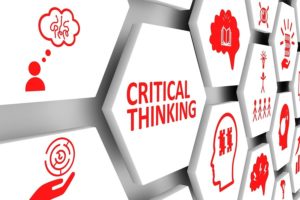 What skills will your child need to enjoy a rewarding career and life? We keep hearing about the importance of STEM – science, technology, engineering and math. Because we live in a multicultural community, many employers want people with world language skills. If you had to pick just one skill that young people need to master – and many schools don’t teach today — it’s critical thinking.
What skills will your child need to enjoy a rewarding career and life? We keep hearing about the importance of STEM – science, technology, engineering and math. Because we live in a multicultural community, many employers want people with world language skills. If you had to pick just one skill that young people need to master – and many schools don’t teach today — it’s critical thinking.
Children need to have flexible minds that can readily absorb new information and respond to complex problems. We must develop their critical thinking skills to thrive in a complex global economy, where questions rarely have just one right answer.
Educator Brian Oshiro says we can help our children learn to think critically by asking these questions:
- Go beyond “what?” — and ask “how?” and “why?”
If a teacher asks a student a question like “What are the main causes of climate change,” it can be Googled in seconds. The student comes away feeling like they know a topic, but their knowledge is only superficial.
At home, you can carry that discussion further by asking: “How does X cause climate change?” and “Why should we worry about it?” To answer, your child needs to really think about a subject – in addition to knowing the facts. You could also ask: “Why should we in Atlanta worry about climate change?” If you localize questions, Oshiro says that gives kids “an opportunity to connect whatever knowledge they have to something personal in their lives.”
- Follow it up with “How do you know this?”
If a student can provide some sort of evidence, they’ll be prepared to defend their answer if someone disputes it. It’s also important to identify a specific source and understand its credibility. It’s too easy for students to say they read it online. They need to assess the sources where they get their information.
- Prompt them to think about how their perspective may differ from other people’s.
Ask a question like “Why should people living in X country or X city worry about climate change?” Kids will be pushed to think about the priorities and concerns of others, says Oshiro, and to try to understand their perspectives — essential elements of creative problem-solving.
- Finally, ask your child how to solve this problem.
Focus your question on a narrow slice of the big problem of climate change. For example, rather than ask “How can we solve climate change?” — which is too big for anyone to wrap their mind around — ask “How could we address and solve cause X of climate change?” Answering this question will require kids to synthesize their knowledge. Keep asking for a variety of approaches: What scientific solution could address cause X? What’s a financial solution? Political solution?
You can start this project any time on any topic; you don’t have to be an expert on what your kids are studying. The purpose is to teach them to think for themselves. Your role is to direct their questions, listen and respond. These are tools that can help learners of all ages. Keep an open mind and remember that many questions don’t have one right answer.
Source: TED Talk by Brian Oshiro
